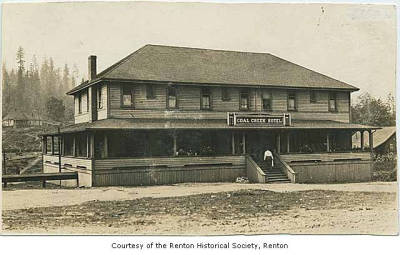Bicycling through history

 At least once a month, I test my conditioning by pedaling up to the top of Cougar Mountain. It's a 5-mile ride from my home, and my goal one day is to reach it in 25 minutes.
At least once a month, I test my conditioning by pedaling up to the top of Cougar Mountain. It's a 5-mile ride from my home, and my goal one day is to reach it in 25 minutes.
About three-quarters of the way up, across the entrance to the Cougar Mountain Regional Park, I pass an open field where there's an old, mossy concrete wall that has a tree growing out of it.
I was surprised to learn a few months ago that this is the ruins of a hotel built about 100 years ago in an area once heavily populated by workers in the coal mine industry.
Few remains
To visit this area today, you wouldn't expect that more than 3,000 people lived close by. It's all either parkland or green open space now, except for a couple of farm houses, until you get closer to the top of the mountain where expensive mega-homes stand.
From what's now known as Newcastle Golf Club Road (formerly Newcastle Coal Creek Road), this wall is the only visible evidence of this area's thriving coal mine industry. Scattered throughout the woods are old mine airshafts and entrances, a railroad turntable, and the overgrown baseball field for Red Town, now extinct.
The wall is actually the remains of the boiler room for the hotel. The above photo from the Renton Historical Society was taken about 1915. (I shot the picture of the wall after a recent snowfall.) A grocery store also once stood in what's now an open field.
Rise and fall
Coal-mining started on this side of Lake Washington in the 1860s, not long after white settlers ended up in nearby Seattle. The coal not only served railroad companies, but was shipped south to San Francisco. Many of the trails in the nearby parks got their start as roads or narrow-gauge railroads that served the mines.
A number of factors led to the decline of the coal industry in the area — the small size of the mines, labor unrest, great use of hydroelectric power. Most were played out by the 1930s, and statewide the industry ended in the 1960s.
But just like the old miner's cabin down hill, there are still remnants of the coal industry that survive today, even as the suburbs grow.
I'm always surprised by these discoveries, and they help give me a fresh perspective on my rides. Everytime I pass this field, I think about the hotel and who might have stayed there.

Recent Comments